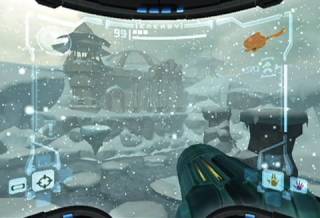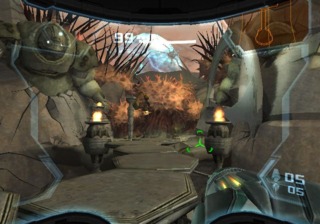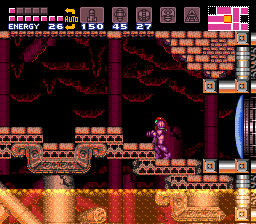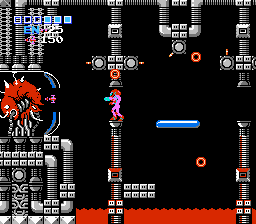Metroid and Me, Part 3: Frozen Utopia
By majormitch 8 Comments
Welcome back for part three of “Metroid and Me!” This is my seven part blog series where I take a long, hard look at why the Metroid franchise has connected with me so strongly over the years. If you haven’t read the first two installments, I highly recommend doing so before tackling part three; you can find links to them below. Not only do they explain everything this series is about, but there’s a lot of overlap between each part, and I’m writing them in such a way that’s better digested in order. The transition between parts two and three is perhaps the perfect example of this. Last week I talked about Metroid’s sense of adventure being a substantial driving force of the experience, but that adventure only works if the space you’re exploring is adequately enticing. Thankfully, the worlds of Metroid are very much worth the trek, and one of the primary reasons for that is the topic of today’s entry: their thick atmosphere.
| Remix Title: Frozen Utopia | Original Song: Ice Valley (Metroid Prime, 2002, GameCube) |
| Remixer(s): Mesmonium | Original Composer(s): Kenji Yamamoto and Kyoichi Kyuma |
Frozen Utopia
You’ve just traversed a lengthy series of fiery underground caverns. Your suit managed to keep the oppressive heat at bay, but avoiding deadly lava and fending off the ferocious creatures that make such caverns their home has been trying. These caverns were merely a thoroughfare to your true destination, however, to which you’ve now arrived. You punch the elevator button to ride to higher ground, and to cooler temperatures. When you arrive, those temperatures may be cooler than expected; you are immediately blinded by bright white snow, and chilled by freezing winds. It’s equal parts beautiful and dangerous, and it’s the next step in your scenic yet perilous adventure.

Environments like these are common within the Metroid universe, and their atmospheres set the tone for the entire adventure. Take the arctic area described above, which is Metroid Prime’s chilly, mountainous Phendrana Drifts. When you enter this area for the first time, it’s immediately apparent how cold it is. Everything is either covered in perfect white snow, or enshrined in rock solid ice. You can both see and hear sharp, swirling winds, and the snow crunches under your feet with each step you take. The ice beetles and baby sheegoth that inhabit the area are practically made of ice; anything less is not likely to survive such harsh conditions. And when you disturb them, they’ll use that ice against you. You discover ancient Chozo ruins covered in ice, remnants of the once mighty race buried by the raw power of the elements. The music that plays also sounds cold. It contains high-pitched, staccato notes that are suggestive of clanging ice, and it moves with a cadence that seems slowed by the conditions, despite its clear determination. All of these audiovisual cues meld together to help Phendrana Drifts punch through the safe barrier of your television screen to make you feel how cold and dangerous it is. It’s a powerful example of the effect a strong atmosphere can have on an game, and how it can add a lot of flavor and context to areas that would otherwise have none. And that’s only a single area, in a single Metroid game.
By packing in so much detail, history, and life into each of its environments, Metroid makes traversing them much more than a collection of video game rules, physics, and other machinery. The thick atmosphere generated by these majestic settings leverages the audiovisual potential within the medium to trigger your senses and guide your emotions, all without interrupting your expedition. It’s always there as you traverse the series’ many different areas, coloring every step of your journey. Brinstar’s expansive caverns, lively wildlife, and bombastic melodies fill me with determination, and encourage me to explore with gusto. Maridia’s underwater grave and creepy tones create a foreboding mood I can’t shake. Lower Norfair’s fiery construction and militant beats have me sweating and ready for war. Witnessing the Space Pirates’ experiments in the Phazon Mines gives me a glimpse of the horrors that exist beneath the surface. Torvus Bog’s sticky and poisonous swamps, aggressive creatures, and dirty music have me carefully and nervously checking every step I take. I could go on and on with such examples; the environments of Metroid run the gamut, and each one creates its own unique atmosphere. Better yet, these seemingly disparate areas connect and flow together wonderfully to paint a much larger picture. The atmospheres of each environment combine to form a holistic setting that’s never jarring, and equally thematic as it transitions between its many exciting locales.

Such thick atmosphere begins, first and foremost, with stunning art direction. Metroid’s technology has always been proficient, but it’s how it uses that tech to power its wonderful art that makes it pop. Lush natural environments, dirty space stations, and grotesque monsters paint a universe that is very much alive and full of interesting things to see. But more than simply being lovely to look at (which it very much is), Metroid has always conveyed a lot of information through its artwork, which works for both the physical objects it depicts, as well as the tone it sets. There’s an unfathomable amount of visual detail applied to every inch of these vast worlds, and that detail can be used for any number of purposes. It can help elaborate on the nature of said environment, such as what plants or creatures live there, and how life is sustained. It can contain all sorts of historical tidbits, revealing lore or recent events through dead bodies, ancient ruins, or accessible data terminals. It can provide useful landmarks that help you find your way as you explore. Or it can simply add to the mood; rain can make a planet seem more dour, an abandoned space station reeks of mystery and dread, and a deadly swamp can appear prickly and combative. This list goes on and on, but at some point it’s difficult to fully convey with words how atmospheric the art of Metroid can be. Experiencing these environments in motion, where you can look around and soak in the details yourself, can be stunning at times.
Just as important to Metroid’s atmosphere is its music. It’s no secret that I’m a huge proponent of great video game music, and the tunes of Metroid showcase precisely why I believe it can be so powerful. As I alluded to in some of my earlier examples, each area is accompanied by a highly thematic song that sets the tone for said area. The contemplative, explorative chords of Tallon IV’s overworld do a great job at piquing my curiosity, and leave me eager to set out on an adventure. Lower Norfair’s deathmarch makes an already intense, dangerous, and lava-filled area feel even more suffocating. The dirty beats of Torvus Bog feel organic in a strangely unnerving way, much like the swamp itself. Again, I could go on and on with examples, or even direct you to more music samples. But Metroid’s music works best in the context of its areas, and remains one of the prime examples of music’s ability to enhance our gaming experiences; it’s hard to convey just how much life they add to each and every environment with words alone. Furthermore, the variety in the music is every bit as dynamic as the variety of the areas themselves. When you transition from hot underground caverns to icy mountains, the music smoothly transitions with you. It goes a long way towards ensuring that these worlds feel cohesive and real, and it all comes together to make these atmospheres seamless and consistently effective. Metroid establishes mood through music about as well as any game out there.

Put more bluntly, Metroid looks and sounds incredible, as it creates atmospheres that get me invested in the worlds I’m exploring. Being invested in said worlds is extremely important to me; as I mentioned before, Metroid’s strong sense of adventure would be for naught if these places weren’t sufficiently exciting. It’s the side of the Metroid formula that appeals to my less mechanical side too. While I tend to be a more mechanics-focused person in general, particularly when it comes to games, it’s the ones where strong mechanics are bolstered by an equally enticing presentation that leave the biggest mark. And for me and my personality, Metroid’s presentation connects very strongly. I’m someone who takes in vast amounts of information through my senses; I see, hear, and smell the world around me to a high degree. I notice and feel the physical space I’m in greatly, and value my presence within it. I put a lot of stock in the details that define such spaces, and interacting with them is primarily how I interact with the world at large. Everyone does this differently; some may take more philosophical or social or emotional approaches to interacting with the world, and as such different atmospheres affect us all differently. But I’ve always been driven externally by my senses. I like the physicality of the natural world, the information it quietly conveys, and the raw power of the elements. There’s simultaneously a directness and a richness there that grabs me, and that’s precisely what Metroid’s atmospheres capture. They wrap the series’ well-oiled mechanics within layers of wonderful sights and sounds, which enhances my experience immeasurably.

Finally, Metroid’s strong atmosphere also wins me over in how it conveys its narrative. Last week I mentioned how Metroid communicates its happenings subtly through environmental clues, as well as the player's own actions. This storytelling philosophy is firmly ingrained within the games’ atmospheres themselves; in a way, atmosphere is Metroid’s primary storytelling device. The only way you know what happens is through what you, the player, see, hear, and do. I already suggested how that type of storytelling can be more resonant for me, and it works precisely because Metroid’s atmospheres are so capable at conveying information. When I’m playing a game, I primarily want to be playing; that comes from the more action-oriented side of my personality, the closet thrill-seeker I previously mentioned. I understand that there is a time and place for direct exposition, and I will indulge it when needed. But I have a lot more appreciation and respect (and ultimately enjoyment) for a game that can convey information without ripping the player out of their natural form of play. Imagine if, as you were exploring Metroid’s lush settings, you had to stop and listen to a villain monologue. It would instantly ruin all of the immersive atmosphere the game worked so hard to create. Not every Metroid game is perfect here, but the best ones know that their environments are so strong that they can perform the storytelling all by themselves. They tell you everything you need to know through sights and sounds alone, and confidently guide your actions and your exploration without the slightest interruption. That’s the power of strong atmosphere, and Metroid’s have sucked me in time and again.
There’s a great, somewhat famous moment that can happen while playing Metroid Prime. At any point when you’re underwater, if you fire a charged beam shot you will briefly see Samus Aran’s reflection on the inside of your visor. It’s a seemingly minor visual detail, but it also serves as a poignant example of the lengths Metroid goes to to pull you into its worlds. You’re a person in a suit, behind a visor, who is in dangerous territory armed with powerful weaponry. It’s all there, conveyed through nothing more than audiovisual information, in a way that makes you feel it in your very core. Metroid brings its worlds to incredible life through its atmosphere, which goes a long way towards making exploring these worlds a nonstop thrill for me. But while atmosphere is a necessary piece that makes these worlds so fun to explore, it’s not the only one. Next week I’ll continue to talk about what makes these worlds so great, but shift from the aesthetic to the mechanical: their excellent world design.
